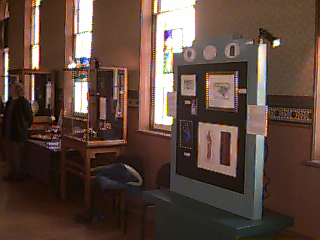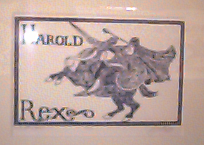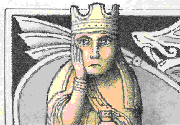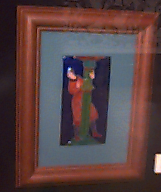



Caz is an artist and teacher living in Kitchener. For the past twenty years he has been a part of the Society for Creative Anachronism., a medieval recreation society. He received an Honours B.A. in Art with a minor in Classical Studies (U. of Waterloo, 1988), which opened up new possibilities in mediums that are not in widespread current use. Wood engraving, the creation of an image by hand carving it into a block of end grain of hard Maple, is an historic medium once used in the same way that photography is today. The use of end grain enables much finer detail than would otherwise be possible in a block print. Caz also works in silverpoint, stained glass, acrylic, and has done calligraphy and illumination from a number of different times and cultures. (Caz's wood engraving 'Thus Spoke Sir Finnvarr' was used on the exhibit poster.)

The Image presented in this exhibit is of the crucial moment of the battle of Hastings. The battle might have had a much different ending had not Harold been mortally wounded by a Norman arrow. In keeping with the theme of the show, the figure is drawn in a style similar to that found in manuscripts contemporary with the Bayeux Tapestry. The stylistic sources for this image include the sketchbook of Villard de Honnecourt, manuscripts that are in the online catalogue of the Bodlian library and collections of medieval drawings from other contemporary manuscripts.
Steven paints in watercolour, gouache, oil, and acrylics, as well as working in antler, bone, and wood, creating both decorative and functional pieces. He has received international awards for his carvings in pre-Romanesque Scandinavian styles. His pieces have been acquired by Heritage Canada and the Smithsonian Institution, and by private collections in Canada, the United States, El Salvador and Brazil. (Steven's 'The Queen in Winter' formed the central panel for the exhibit poster.)
A reproduction based on Viking utility knives, the handle is decorated with a gripping beast in the Mammen style. Medieval soldiers were looters by nature (as shown in the margins of the Bayeux Tapestry), so this is the type of object which would likely have changed hands twice in 1066, at the Battle of Stamford Bridge and later at Hastings. (Blade forged by Darrell Markewitz)

This image came to mind while I was in Newfoundland earlier this winter, watching the snow fall into the North Atlantic. It reflects the entry of the Normans and the English into the Romanesque mainstream of Western Europe from their northern, tribal, origins. The Queen is based on the walrus-ivory chessmen found in the Isle of Lewis, while the serpent is based on Viking carvings.
The decorative arts of the Vikings contain forms which are ideal for purely abstract art. This piece contains elements of such forms from the Ringerike style, one of the last periods of Viking art. The influence of this style can be seen in some of the marginal figures of plants and animals in the Bayeux Tapestry.
John is a designer and metalsmith who has been working primarily in precious metals for the last 20 years. He and his wife, Julia MacDougall, operate DELO Designs Ltd. from their studio in Woodstock, Ontario offering a wide variety of fine jeweler, metal art and collectables. "I'm part metal technician who loves to dabble in the how and why things work the way they do. I'm part designer, once I understand a particular aspect of metallurgy, technology or a technique then I want to create and explore by combining the knowledge with other influences from my life."
The raw material of architecture is space and architecture is one of the most enduring statements of influence. Much of what is known of the architecture of the time is discovered from the monastic buildings. In the case of the 10th century and earlier, only the secondary structures remain and there are few. The arrival of the Normans, in 1066, was to herald the beginning of an architectural movement. In time this would lead to the English being the architectural leaders of later centuries.
This piece explores the architectural achievements of themonastic revival in the 10th century. This Anglo-Saxon architecture is the first group of buildings to embody the spirit of order, magnificence and most importantly monumental scale. Though the walls and arches are still thick and heavy, the height and size of these structures show a marked increase in the amount of space enclosed by their construction. However upon their arrival the Normans would find these structures still too small for their religious needs.
The Norman conquest of 1066 allowed for greater continental influence in design and construction of monastic buildings. By the last quarter of the century the style known as Anglo-Norman Romanesque was establishing its self as a recognizable style of architecture. This piece reflects the ever increasing size and grandeur of the structures and the introduction of ribbed vaulting.
By the last quarter of the 12th century the development of early gothic architecture is under way and the buildings are enclosing more space than ever. The development of better stone cutting tools is allowing for greater height and thinner walls. More windows as well as the straight lines associated with Gothic architecture are beginning to appear.
Brenda Roy is an international award-winning designer whose work has appeared in television and film as well as being available in galleries across the province. While much of her work is inspired by Celtic and Medieval art, Brenda's jewellery is at its core an exploration of contrasts in metal and stone: smooth stone and polished metal defined by deep, textured backgrounds; the play of colours in the unique stone inlays; precious gems paired with rough minerals.
"The historical artifacts are only a starting point for my design process. I will often look at an artifact and create and entire piece from one tiny detail or conversely ignore everything except the most overall outline. What emerges are contemporary pieces that hold echoes of the past." A graduate of the Jewellery and Metals program at Georgian College in Barrie (after a career as a professional stage-manager) she now works out of her studio in Alliston, Ontario. She is a member of the Society of Jewellery Historians. In Woodstock, her work is available through John Hughes / DELO Designs. (Brenda is a member of An Droichead)
This piece is inspired by the richness and colour of the jeweled reliquary covers of the period, such as the head reliquary of Pope Alexander (Mosan, Brussels, early 12th century) or the Lothair Cross (Ottonian Empire, ca.1000AD)
The Lewis Chessmen are from an early 12th century set from the Isle of Lewis in the Outer Hebrides of Scotland. I have always loved the exquisitely mournful looks on the faces of the pieces and have here used a face from one of the kings.
In this brooch I have reduced one of the warders (pawns) to its most basic existence as an arrangement of triangles, creating both a modern abstract design and a very clear, simple representation of a Norse warrior with his sword and shield.
Catherine's study of history and archaeology has always driven her sense of design. She uses design repertoire from as early as 8th BC and as late as 12th c AD. Inspired particularly by Celtic enamellists from as early as 200 BC, she began by doing reproductions of early designs. This was motivated, in part, by an attempt to come to an understanding of the relationship with symbol that inspired early artistic endeavour.
Catherine believes that for early peoples, there was a direct relationship between nature, life, religion, and art. In modern technological society this direct connection is cut, life is compartmentalized and the primitive sense of unity is missing. She hopes, in her work and through education, to communicate some of that lost sense of unity.
Her focus is to look backwards and forwards: to work with a historical grammar, and yet produce work that is meaningful in today's community. Each piece that she creates has its own story, informed by research into early history, archaeology, or folklore. Catherine's work mirrors the past, and speaks to the present through ancient symbols. (Catherine is a member of An Droichead)
Since the medium in which one works always dictates to a certain extent what one can do - I chose this as a good design to render in Champlevé - my own favourite technique. It evokes some of the Celtic and Anglo-Saxon interlacing from an earlier period, and sets up the background in which the Tapestry was created. I have taken considerable artistic liberties - but the essential feeling of movement, which I saw in the original tree, is the theme I have tried to carry through.

The furtive lines of this lurking courtier suggested to me cloisonné as the ideal enamelling medium. Again I have taken considerable liberties, especially with the colour. As the Tapestry embroiderer would have been limited by the dyes he could use, I have chosen to render the image in the vibrant tones possible with leaded enamels.
One of the things that struck me about the Tapestry was its secular theme. Most artifacts from the medieval period reflect a religious sensibility. So when I went looking into the background of the Anglo-Saxons, I chose another secular theme - Beowulf. The artistic style of these panels is Viking: they are meant to mirror the essentially heroic morality that was the heritage of both the Normans and the Anglo-Saxons.
The essential ingredient that separated the Normans from the Anglo Saxons was Frankish influence. Again I have chosen a secular theme: The Song of Roland. The design comes from the 'Rolandslied' an illustrated manuscript telling the story of Charlemagne. The enameling style is unusual, but contemporary. It originated in the Mosan workshops of Meuse Valley of Belgium and northern France. At a time when transparent enamels were unknown, it was an attempt to render depth and perspective by laying opaque shades of similar tone next to one another. It was greatly influenced by manuscript art (most pieces being copies of manuscript illustrations) which reached it's flowering in Anglo-Saxon England.
